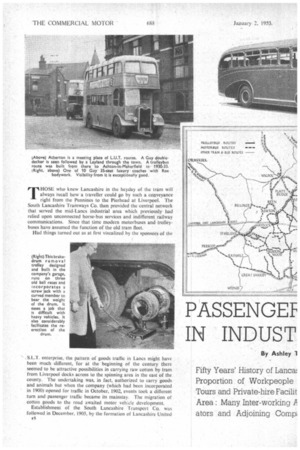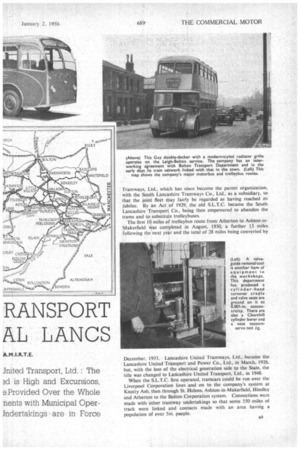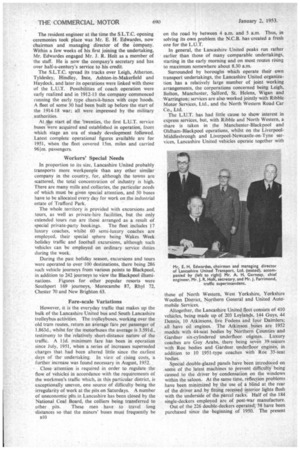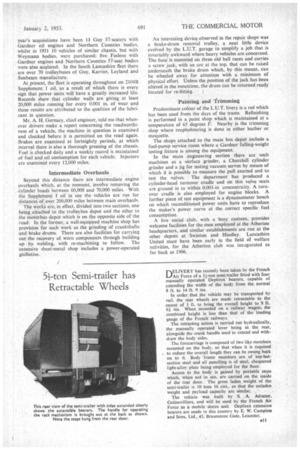PASSENGEF RA\TSPORT IN INDUST AL LAN CS
Page 42

Page 43

Page 44

Page 45

If you've noticed an error in this article please click here to report it so we can fix it.
By Ashley 1
A. M .1. R.T. E.
Fifty Years' History of Lanca: Proportion of Workpeople Tours and Private-hire Facilit Area : Many Inter-working P. ators and Adjoining Comp
_hilted Transport, Ltd. The pd is High and Excursions, e Provided Over the Whole nents with Municipal OperJndertakings are in Force
THOSE who knew Lancashire in the heyday of the tram will always recall how a traveller could go by such a conveyance right from the Pennines to the Pierhead at Liverpool. The South Lancashire Tramways Co. then provided the central network that served the mid-Lancs industrial area which previously had relied upon unconnected horse-bus services and indifferent railway communications. Since that time modern motorbuses and trolleybuses have assumed the function of the old tram fleet.
Had things turned out as at first visualized by the sponsors of the S.L.T. enterprise, the. pattern of goods traffic in Lanes might have been much -different, for at the beginning of the century there seemed to be attractive possibilities in carrying raw cotton by tram from Liverpool docks across to the spinning area in the east of the county. The undertaking was, in fact, authorized to carry goods and animals but when the company (which had been incorporated in 1900) opened for traffic in October, 1902, events took a different turn and passenger traffic became its mainstay. The migration of
cotton goods to the road awaited motor vehicle development. Establishment of the South Lancashire Transport Co. was followed in December. 1905, by the formation of Lancashire United rS
Tramways, Ltd., which has since become the parent organization, with the South Lancashire Tramways Co., Ltd., as a subsidiary, so that the joint fleet may fairly be regarded as having reached its jubilee. By an Act of 1929, the old S.L.T.C. became the South Lancashire Transport Co., being then empowered to abandon the trams and to substitute trolleybuses.
The first 10 miles of trolleybus route from Atherton to Ashton-inNakerfield was completed in August, 1930, a further 13 miles following the next year and the total of 28 miles being converted by December, 1933. Lancashire United Tramways, Ltd., became the Lancashire United Transport and Power Co., Ltd., in March, 1926, but, with the loss of the electrical generation side to the State. the title was changed to Lancashire United Transport, Ltd., in 1948.
When the S.L.T.C. first operated. tramcars could be run over the Liverpool Corporation lines and on to the company's system at Knotty Ash, then through St. Helens, Ashton-in-Makerfield, Hindle)? and Atherton to the Bolton Corporation system. Connections were made with other tramway undertakings so that some 550 miles of track were linked and contacts made with an area having a population of over 5m. people.
The resident engineer at the time the S.L.T.C. opening ceremonies took place was Mr. E. H. Edwardes, now chairman and managing director of the company. Within a few weeks of his first joining the undertaking, Mr. Edwardes engaged Mr. J. R. Holt as a member of the staff. He is now the company's secretary and has over half-a-century's service to his credit.
The S.L.T.C. spread its tracks over Leigh, Atherton, Tyldesley, Hindley, Ince, Ashton-in-Makerfield and Haydock, and later its operations were linked with those of the L.U.T. Possibilities of coach operation were early realized and in 1912-13 the company commenced tinning the early type chars-a-bancs with cape hoods. A fleet of some 30 had been built up before the start of the 1914-18 war; all were impressed by the military authorities.
At the start of the 'twenties, the first L.U.T. service buses were acquired and established in operation, from which stage an era of steady development followed. Latest complete operational figures available are for 1951, when the fleet covered 15m. miles and carried 961m. passengers.
Workers' Special Needs
In proportion to its size, Lancashire United probably transports more workpeople than any other similar company in the country, for, although the towns are scattered, the total concentration of industry is high. There are many mills and collieries, the particular needs of which must be given special attention, and 50 buses have to be allocated every day for work on the industrial estate of Trafford Park.
The whole territory is provided with excursions and tours, as well as private-hire facilities, but the only extended tours run are those arranged as a result of special private-party bookings. The fleet includes 17 luxury coaches, whilst 60 semi-luxury coaches are employed, their special sphere being Wakes Week holiday traffic and football excursions, although such vehicles can be employed on ordinary service duties during the week.
During the past holiday season, excursions and tours were operated to over 100 destinations, there being 286 such vehicle journeys from various points to Blackpool, in addition to 242 journeys to view the Blackpool illuminations. Figures for other popular resorts were Southport 169 journeys, Morecambe 87, Rhyl 72, Chester 70 and New Brighton 63.
Fare-scale Variations However, it is the everyday traffic that makes up the bulk of the Lancashire United bus and South Lancashire trolleybus activities. The trolleybuses, working over the old tram routes, return an average fare per passenger of 1.863d., whilst for the motorbuses the average is 3.591d., testimony to the relatively short-distance nature of the traffic. A lid. minimum fare has been in operation since July, 1951, when a series of increases superseded charges that had been altered little since the earliest days of the undertaking. In view of rising costs, a further increase was found necessary in August, 1952. , Close attention is required in order to regulate the flow of vehiclei in accordance with the requirements of the workmen's traffic which, in this particular district, is exceptionally uneven, one source of difficulty being the irregularity of work at the pits on Saturdays. A number of uneconomic pits in Lancashire has been closed by the National Coal Board, the colliers being transferred to other pits. These men have to travel long .distances so that the miners' buses must frequently be
n10 on the road by between 4 a.m. and 5 a.m. Thus, in solving its own problem the N.C.B. has created a fresh one for the L.U.T.
In general, the Lancashire United peaks run rather earlier than those of many comparable undertakings, starting in the early morning and on most routes rising to maximum somewhere about 8.30 a.m.
Surrounded by boroughs which operate their own transport undertakings, the Lancashire United organization has a relatively large number of joint working arrangements, the corporations concerned being Leigh, Bolton, Manchester, Salford, St. Helens, Wigan and Warrington; services are also worked jointly with Ribble Motor Services, Ltd., and the North Western Road Car Co., Ltd.
The L.U.T. has had little cause to show interest in express services, but, with Ribble and North Western, a share is taken in the Manchester-Blackpool and Oldham-Blackpool operations, whilst on the LiverpoolM iddlesbrough and Liverpool-Newcastle-on-Tyne services, Lancashire United vehicles operate together with those of North Western, West Yorkshire, Yorkshire Woollen District, Northern General and United Automobile Services.
Altogether, the Lancashire United fleet consists of 410 vehicles, being made up of 203 Leylands, 144 Guys, 44 Dennis, 10 Atkinsons, five Foderis and four Daimlers; all have oil engines. The Atkinson , buses are 1952 models with 44-seat bodies by Northern counties and Gardner six-cylindered underfloor. engines. Luxury coaches are Guy Arabs, there being Seven 39-seaters with Roe bodies and Gardner underfloor engines, in addition to 10 1951-type coaches with Roe 35-seat bodies.
Special double-glazed panels have been introduced on some of the latest machines to prevent difficulty being caused to the driver by condensation on the windows within the saloon. At the same time, reflection problems have been minimized by the use of a blind at the rear of the driver and by fitting recessed interior lights flush with the underside of the parcel racks: Half of the 184 single-deckers employed are of post-war manufacture. Out of the 226 double-deckers operated; 38 have been purchased since the beginning of 1950. The present
year's acquisitions have been 11 Guy 57-seaters with Gardner oil engines and Northern Counties bodies, whilst in 1951 10 vehicles of similar chassis, but with Weymann bodies, were purchased; five Fodens with Gardner engines and Northern Counties 57-seat bodies were also acquired. In the South Lancashire fleet there are over 70 trolleybuses of Guy, Karrier, Leyland and Sunbeam manufacture.
At present, the fleet is operating throughout on 210411 Supplement I oil, as a result of which there is every sign that power units will have a greatly increased life. Records show that cylinder walls are giving at least 20,000 miles running for every 0.001 in. of wear and these results are attributed to the qualities of the lubricant in question.
Mr. A. H. Gernaey, chief engineer, told me that whenever drivers make a report concerning the roadworthiness of a vehicle, the machine in question is examined and checked before it is permitted on the road again. Brakes are examined at fortnightly periods, at which interval there is also a thorough greasing of the chassis. Fuel is checked daily and a weekly record is maintained of fuel and oil consumption for each vehicle. Injectors are examined every 12,000 miles.
Intermediate Overhauls Beyond this distance there are intermediate engine overhauls which, at the moment, involve removing the cylinder heads between 60,000 and 70,000 miles. With the Supplement I oil in use the vehicles are run for distances of over 200,000 miles between main overhauls.
The works arc, in effect, divided into two sections, one being attached to the trolleybus depot and the other to the motorbus depot which is on the opposite side of the road. In the former, a well-equipped machine shop has provision for such work as the grinding of crankshafts and brake drums. There are also facilities for carrying out the recovery of worn components through building up by welding, with re-machining to follow. The extensive sheet-metal shop includes a power-operated guillotine.
An interesting device observed in the repair shops was a brake-drum removal trolley, a neat little device evolved by the L.U.T. garage to simplify a job that is invariably awkward where heavy vehicles are concerned. The base is mounted on three old ball races and carries a screw jack, with an arc at the top, that can be raised underneath the brake drum which, by this means, can be wheeled away for attention with a minimum of physical effort. Unless the position of the jack has been altered in the 'meantime, the drum can be returned ready located for re-fitting.
Painting and 'trimming Predominant colour of the L.U.T. livery is a red which has been used from the days of the trams. Refinishing is performed in a paint shop which is maintained at a temperature of 65 degrees F. Nearby is the trimming shop where reupholstering is done in either leather or moquette.
The shops attached to the main bus depot include a fuel-pump service room where a Gardner falling-weight testing fixture is among the equipment.
In the main engineering section there are such machines as a surface grinder, a Churchill cylinder grinder and a jig for testing vacuum servos by means of which it is possible to measure the pull exerted and to test the valves. The department has produced a cylinder-head turnover cradle and on this valve seats are ground in to within 0.001-in concentricity. A turnover cradle is also employed for engine blocks. A further piece of test equipment is a dynamometer bench on which reconditioned power units have to reproduce the maker's power curve at the correct specific fuel consumption.
A live social club, with a 'busy canteen, provides welcome facilities for the men employed at the Atherton headquarters, and similar establishments are run at the other depots at Swinton and Hindley. Lancashire United must have been early in the field of welfare activities, for the Atherton club was inaugurated as far back as 1906.




















































































